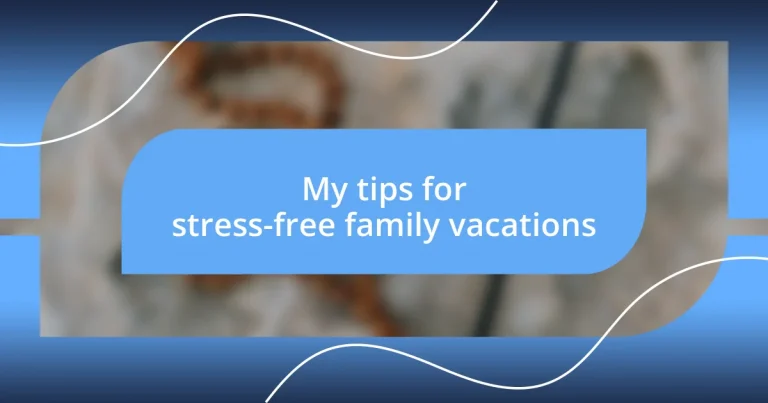Key takeaways:
- Involve the whole family in the vacation planning process to boost excitement and investment in shared experiences.
- Maintain a flexible itinerary to embrace spontaneity and create memorable moments during the trip.
- Communicate openly to manage expectations and address various interests, ensuring everyone feels valued and included.

Planning your family vacation
When planning a family vacation, I always start with a family meeting. It may sound simple, but this is where we gather everyone’s input—dream destinations, activities, and even budget ideas. Have you ever noticed how much more excited kids get when they feel their opinions matter? This collaborative approach not only bonds us but also sets clear expectations.
I remember one trip where I thought I was being super organized by handling all the details myself. But as it turned out, my kids had their hearts set on seeing a specific theme park. It was a last-minute adjustment, but including their wishes transformed our trip from good to absolutely unforgettable. It made me reflect on how important it is to incorporate everyone’s preferences; after all, a family vacation is about making memories together.
Don’t forget to build in some flexibility to your plans. I once had the most meticulously organized itinerary, only for a sudden rainstorm to throw a wrench in it. Instead of panicking, we embraced it—hot cocoa in a café and an impromptu indoor game day became cherished memories. So, as you create your family vacation plan, think about how to weave in spontaneous fun moments along with your scheduled activities! Wouldn’t it be great if every trip felt seamless yet adventurous?

Choosing the right destination
Choosing the right destination can make or break a family vacation. I’ve found that aligning our family interests with potential locations really enhances the experience. For instance, my family’s eagerness for outdoor adventures led us to a lake cabin instead of the bustling city I’d initially chosen. The kids were thrilled to kayak and explore nature trails, creating memories I knew they’d cherish forever. Adjusting to their preferences turned what could have been a typical vacation into a delightful exploration together.
Consider the following factors when selecting your destination:
- Interests: Does everyone have an activity they enjoy?
- Ages: Are there suitable attractions for younger kids or teens?
- Budget: Can the destination accommodate your financial plan?
- Accessibility: How easy is it to travel there?
- Safety: Is it a secure environment for family activities?
Choosing a destination that resonates with everyone’s desires not only reduces stress but also paves the way for a joyful vacation where every family member feels included.

Setting a flexible itinerary
Setting a flexible itinerary can significantly enhance the enjoyment of any family vacation. When I plan, I ensure that our daily schedule includes core activities but leaves room for spontaneous adventures. For instance, during a beach trip, we had set times for activities like snorkeling but also kept afternoons open for unexpected explorations—like a local festival we stumbled upon. This flexibility allowed us to create unique memories that structured plans alone could never offer.
I recall a particular family vacation where we meticulously plotted our days. Halfway through, we discovered that our kids were much more interested in exploring tide pools than our scheduled sightseeing. Instead of sticking rigidly to our plan, we pivoted. Those unplanned moments led to finding starfish and sea urchins that left us all in awe. Each trip taught me that sometimes the best memories come when you’re willing to let go of the schedule and just enjoy the moment together.
It’s vital to strike a balance between structure and spontaneity. I use a rough outline of the itinerary, marking the places we want to visit while reminding my family that flexibility is key. When I see my kids’ eyes light up at something unexpected, I’m reminded that the journey is just as important as the destination. So, as you craft your family itinerary, think about how you might integrate these moments of joy amidst your plans.
| Structured Itinerary | Flexible Itinerary |
|---|---|
| Rigid schedule with set times | Main activities with adjustable times |
| Less room for spontaneous fun | Encourages exploration of unexpected opportunities |
| Can lead to stress if things go off plan | Reduces stress by embracing changes |

Packing smart for stress-free trips
Packing can set the tone for your entire trip, so a few smart strategies can really ease the stress. I’ve learned that making a packing list well in advance of our departure avoids that last-minute frenzy. For example, when we took a trip to the mountains, I mapped out essential items like warm clothes, hiking gear, and even snacks. Having everything organized ahead of time allowed us to pack leisurely instead of scrambling around at the 11th hour, which is when chaos can ensue.
Another technique I swear by is the art of rolling clothes instead of folding them. It not only saves space but also reduces wrinkles, which I find incredibly helpful. I remember a time when we were heading to the beach, and I rolled all our swimsuits, towels, and lightweight clothes. We managed to fit everything into a single suitcase! This saved us the hassle of juggling multiple bags at the airport while providing more room for souvenirs. Doesn’t that sound appealing?
Lastly, packing a “family fun kit” has become a tradition of ours. I stuff a small bag with travel games, coloring books, and snacks—essentially a go-to for entertainment during transit. On our last road trip, this kit was a lifesaver when we hit traffic. Keeping everyone occupied helped us avoid the classic “Are we there yet?” chorus. When you consider the little things—those tiny comforts—you’ll see how they can turn an ordinary vacation into a memorable adventure.

Involving everyone in planning
When it comes to planning a family vacation, I’ve found that including everyone in the process makes a world of difference. I remember a trip where we all gathered around the dining table with our laptops, maps, and a giant notepad. It was such a joy watching my kids brainstorm their dream activities—everyone felt heard, and that created an excitement that made the countdown to our vacation feel like a celebration. Have you ever experienced how enthusiastic kids can get when they see their ideas materializing? It’s honestly priceless.
By involving my family in the planning, I noticed that the kids became more invested in the vacation. They were excited about researching places they wanted to visit. On our last trip to a national park, for example, they picked out hikes based on their reading—one discovered a trail featuring a waterfall, which turned out to be the highlight of our trip! This involvement not only lessened the stress of planning but also created a sense of ownership over the experience. Isn’t it amazing how a little collaboration can ignite such enthusiasm?
Moreover, I’ve discovered that when everyone feels included, the vacation becomes less of a chore and more of a shared journey. By hosting a family planning night, complete with snacks and brainstorming, we turned a typical planning session into a bonding moment. It’s like opening a treasure chest of options—everyone’s contributions lead to unexpected and delightful plans. What’s your take? When was the last time you let everyone in on the fun of planning? Engaging the whole family can transform the process from a daunting task into an enjoyable memory in its own right.

Managing travel expectations
Managing travel expectations is crucial for a smooth family vacation. One key insight I’ve gathered is to set realistic itineraries. I remember planning a trip to a big city—initially, I had everyone’s must-see attractions crammed into just a few days. It quickly became clear that we were setting ourselves up for frustration. We ended up having to skip some of the highlights because we were too tired to enjoy them. Prioritizing what truly matters and leaving room for spontaneity made all the difference. Have you ever felt rushed on a vacation? Planning less can actually feel like more!
Another aspect of managing expectations is recognizing that not everything will go as planned. There was a time when a sudden rainstorm disrupted our beach day. Instead of sulking, we embraced the moment and went on an impromptu adventure to a nearby coffee shop with board games. That unexpected twist became one of our favorite memories! I’ve learned to remind my family that the journey often holds the best surprises. What is it about unplanned moments that can turn an ordinary day into a cherished memory?
Lastly, communication within the family is essential to align everyone’s hopes and preferences. I often find it helpful to ask open-ended questions—like, “What’s one thing you’re most excited about this vacation?” This not only helps everyone feel valued but also clarifies what experiences matter most to them. During our last trip, my youngest daughter expressed her desire to visit a particular zoo exhibit, which I had initially overlooked. By focusing on shared excitement, we transformed anticipation into an engaging discussion, deeply enriching our vacation experience. So, how do you prioritize everyone’s wishes while managing logistics? It’s a delicate balance, but I believe it’s worth the effort for a stress-free family getaway.

Keeping the peace during travel
Keeping the peace during travel is an art I’ve honed over the years, and one of my most effective strategies involves fostering open communication. I remember one road trip where my kids had different interests; one was keen on historical sites while the other preferred nature trails. By encouraging them to voice their desires, we found common ground—like exploring a historic park that offered both trails and fascinating facts. Isn’t it incredible how simple conversations can transform conflicts into collaborative adventures?
Another tactic that really works for us is creating a travel routine that everyone can latch onto. On a recent family vacation, we designated “family time” every afternoon. During this time, we’d play games, share stories, or even discuss our highlights so far. This not only allowed us to unwind but also provided an opportunity for everyone to express their feelings and thoughts. Have you ever noticed how valuable those little check-in moments can be? They keep tensions low and excitement high.
Also, I’ve realized that managing screen time on long trips helps to maintain the peace. I’ve caught myself getting frustrated when my kids started bickering during a lengthy drive, so we established a “no screens” rule for the first half of the journey. During that time, we played interactive games or listened to audiobooks together. What I found was not only did it minimize arguments, but it also led to some of our most heartfelt conversations. Do you find that unplugging can foster connection during travel? It certainly has in my experience, turning what could be a stressful situation into a cherished memory.














